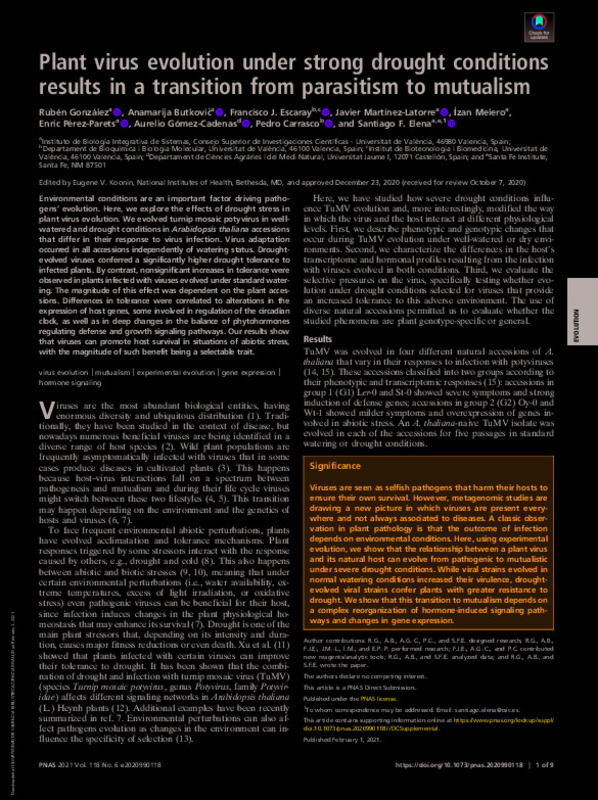JavaScript is disabled for your browser. Some features of this site may not work without it.
Buscar en RiuNet
Listar
Mi cuenta
Estadísticas
Ayuda RiuNet
Admin. UPV
Plant virus evolution under strong drought conditions results in a transition from parasitism to mutualism
Mostrar el registro sencillo del ítem
Ficheros en el ítem
| dc.contributor.author | González, Rubén
|
es_ES |
| dc.contributor.author | Butkovic, Anamarija
|
es_ES |
| dc.contributor.author | Escaray, Francisco J.
|
es_ES |
| dc.contributor.author | Martínez-Latorre, Javier
|
es_ES |
| dc.contributor.author | Melero, Izan
|
es_ES |
| dc.contributor.author | Pérez-Parets, Enric
|
es_ES |
| dc.contributor.author | Gómez-Cadenas, Aurelio
|
es_ES |
| dc.contributor.author | Carrasco, Pedro
|
es_ES |
| dc.contributor.author | Elena, Santiago F.
|
es_ES |
| dc.date.accessioned | 2022-11-09T19:01:31Z | |
| dc.date.available | 2022-11-09T19:01:31Z | |
| dc.date.issued | 2021-02-09 | es_ES |
| dc.identifier.uri | http://hdl.handle.net/10251/189531 | |
| dc.description.abstract | [EN] Environmental conditions are an important factor driving pathogens' evolution. Here, we explore the effects of drought stress in plant virus evolution. We evolved turnip mosaic potyvirus in well-watered and drought conditions in Arabidopsis thaliana accessions that differ in their response to virus infection. Virus adaptation occurred in all accessions independently of watering status. Drought-evolved viruses conferred a significantly higher drought tolerance to infected plants. By contrast, nonsignificant increases in tolerance were observed in plants infected with viruses evolved under standard watering. The magnitude of this effect was dependent on the plant accessions. Differences in tolerance were correlated to alterations in the expression of host genes, some involved in regulation of the circadian clock, as well as in deep changes in the balance of phytohormones regulating defense and growth signaling pathways. Our results show that viruses can promote host survival in situations of abiotic stress, with the magnitude of such benefit being a selectable trait. | es_ES |
| dc.description.sponsorship | We thank Francisca de la Iglesia and Paula Agudo for excellent technical assistance. This work was supported by Grants PID2019103998GB-I00 and BES-2016-077078 (Agencia Estatal de Investigacion-Fondo Europeo de Desarrollo Regional) to S.F.E. and R.G., respectively; GRISOLIAP/2018/005 and PROMETEU2019/012 (Generalitat Valenciana) to S.F.E.; and AICO/2019/150 (Generalitat Valenciana) to A.G.-C. Phytohormone measurements were performed at the Servei Central d'Instrumentacio Cientifica of Universitat Jaume I. | es_ES |
| dc.language | Inglés | es_ES |
| dc.publisher | Proceedings of the National Academy of Sciences | es_ES |
| dc.relation.ispartof | Proceedings of the National Academy of Sciences of the United States of America (Online) | es_ES |
| dc.rights | Reconocimiento - No comercial - Sin obra derivada (by-nc-nd) | es_ES |
| dc.subject | Virus evolution | es_ES |
| dc.subject | Mutualism | es_ES |
| dc.subject | Experimental evolution | es_ES |
| dc.subject | Gene expression | es_ES |
| dc.subject | Hormone signaling | es_ES |
| dc.title | Plant virus evolution under strong drought conditions results in a transition from parasitism to mutualism | es_ES |
| dc.type | Artículo | es_ES |
| dc.identifier.doi | 10.1073/pnas.2020990118 | es_ES |
| dc.relation.projectID | info:eu-repo/grantAgreement/AEI/Plan Estatal de Investigación Científica y Técnica y de Innovación 2017-2020/PID2019-103998GB-I00/ES/PAPEL DEL CODIGO EPIGENOMICO DEL HUESPED EN LA EVOLUCION DE LAS POBLACIONES VIRALES/ | es_ES |
| dc.relation.projectID | info:eu-repo/grantAgreement/GVA//GRISOLIAP%2F2018%2F005//Epigenetic complexes as host organizers of plant viral evolution/ | es_ES |
| dc.relation.projectID | info:eu-repo/grantAgreement/GVA//PROMETEO%2F2019%2F012/ | es_ES |
| dc.relation.projectID | info:eu-repo/grantAgreement/GVA//AICO%2F2019%2F150/ | es_ES |
| dc.relation.projectID | info:eu-repo/grantAgreement/AEI//BES-2016-077078/ | es_ES |
| dc.rights.accessRights | Abierto | es_ES |
| dc.description.bibliographicCitation | González, R.; Butkovic, A.; Escaray, FJ.; Martínez-Latorre, J.; Melero, I.; Pérez-Parets, E.; Gómez-Cadenas, A.... (2021). Plant virus evolution under strong drought conditions results in a transition from parasitism to mutualism. Proceedings of the National Academy of Sciences of the United States of America (Online). 118(6):1-9. https://doi.org/10.1073/pnas.2020990118 | es_ES |
| dc.description.accrualMethod | S | es_ES |
| dc.relation.publisherversion | https://doi.org/10.1073/pnas.2020990118 | es_ES |
| dc.description.upvformatpinicio | 1 | es_ES |
| dc.description.upvformatpfin | 9 | es_ES |
| dc.type.version | info:eu-repo/semantics/publishedVersion | es_ES |
| dc.description.volume | 118 | es_ES |
| dc.description.issue | 6 | es_ES |
| dc.identifier.eissn | 1091-6490 | es_ES |
| dc.identifier.pmid | 33526695 | es_ES |
| dc.identifier.pmcid | PMC8017717 | es_ES |
| dc.relation.pasarela | S\428641 | es_ES |
| dc.contributor.funder | Generalitat Valenciana | es_ES |
| dc.contributor.funder | Agencia Estatal de Investigación | es_ES |
| dc.contributor.funder | European Regional Development Fund | es_ES |








